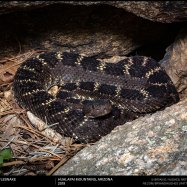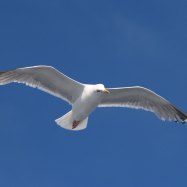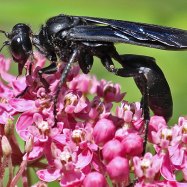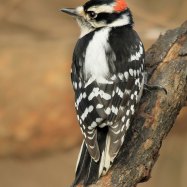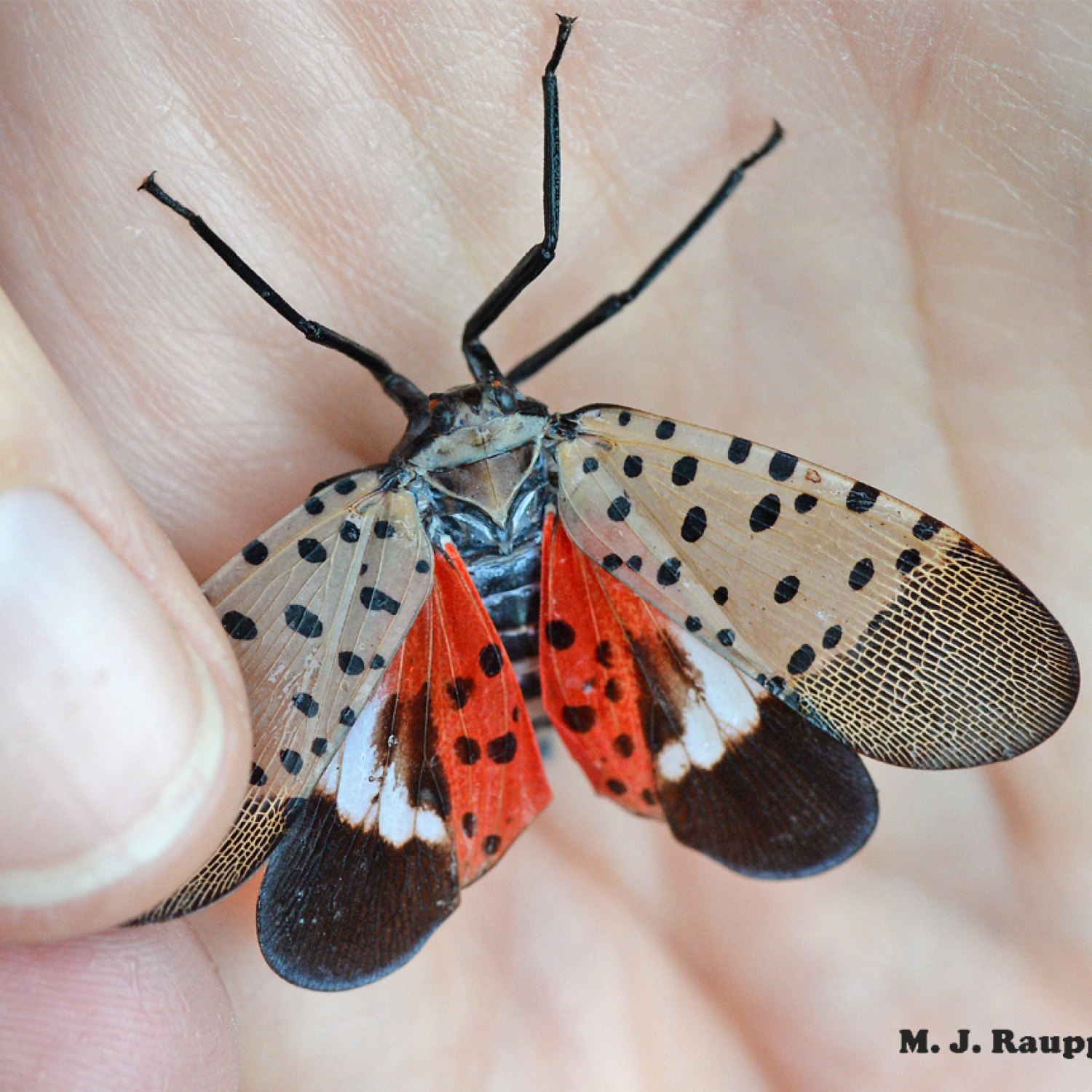
Spotted Lanternfly
Approximately 1 inch (2.5 cm)
Spotted Lanternflies, measuring just around 1 inch, may look small, but don't be fooled by their size. These invasive pests are rapidly spreading in the Northeastern United States and other countries like Canada, South Korea, and Japan. Belonging to the Fulgoridae family, they have a flat and oval-shaped body. Keep an eye out and report any sightings to help control their population! #spottedlanternfly #invasivepests #fulgoridae #northeastusa
Animal Details Summary:
Common Name: Spotted Lanternfly
Kingdom: Animalia
Habitat: Trees, especially Ailanthus altissima (Tree of Heaven)
The Spotted Lanternfly: Invasive Beauty
In many cultures, insects are seen as a symbol of good luck or a nuisance that needs to be rid of. But in the case of the Spotted Lanternfly, also known as Lycorma delicatula, it is seen as an invasive species that threatens not only the environment but also the economy. This insect may seem small and harmless, but its impact can be felt on a global scale.The Origins of the Spotted Lanternfly
The Spotted Lanternfly is native to Asia, specifically in countries like China, Japan, Korea, and Vietnam Spotted Lanternfly. In its native habitat, it is not considered to be a pest. However, it is an entirely different story when it comes to countries outside its natural range.In 2014, the Spotted Lanternfly was first discovered in the United States, specifically in Pennsylvania. It is believed to have hitched a ride on a shipping container from China, and since then, it has rapidly spread throughout the Northeastern part of the country. It has also been reported in Canada, South Korea, and Japan.
Physical Appearance and Habitat
The Spotted Lanternfly may not look like your typical insect, but its striking coloring makes it hard to miss. It measures approximately 1 inch (2.5 cm) in length and has a flat and oval-shaped body. It has a grayish-brown color, with black spots and patches of bright red on its wings and body Scarlet Tanager.This distinctive coloration is a warning to predators that it contains chemicals that make it taste bitter and unpleasant. This adaptation is known as aposematic coloration, and it serves as a defense mechanism for the Spotted Lanternfly.
As the name suggests, the Spotted Lanternfly is often found on trees, specifically the Tree of Heaven (Ailanthus altissima), which also happens to be an invasive species in the United States. It is a deciduous tree, introduced from China in the 1700s, and it is the preferred host plant of the Spotted Lanternfly. The Tree of Heaven is known for its rapid growth and ability to outcompete native plants, making it the perfect habitat for this invasive insect.
Eating Habits and Economic Impact
The Spotted Lanternfly feeds on the sap of trees, using its piercing-sucking mouthparts to extract the nutrient-rich sap. This feeding method can cause significant damage to trees, especially young ones, and can even lead to their death. This has a domino effect on the environment, as trees are crucial for air purification, soil retention, and as habitats for countless other species.But the economic impact of the Spotted Lanternfly goes beyond tree damage. It is also a threat to the agricultural industry, as it feeds on a wide range of plants, including fruits, vegetables, and ornamental plants. For the farming community, this means significant losses in crops and revenue.
According to the United States Department of Agriculture (USDA), it is estimated that the Spotted Lanternfly could cost the U.S. economy over $324 million annually and affect almost $18 billion worth of agricultural commodities. These numbers are alarming and highlight the need for urgent action to control and contain this invasive species.
Efforts to Control the Spread
The rapid spread of the Spotted Lanternfly has prompted authorities to take action to control and contain its population. Biological control methods, such as introducing natural predators of the insect, are being explored, but this can take years to implement successfully.Meanwhile, chemical control methods are being used, but they come with their own set of challenges. The Spotted Lanternfly has shown resistance to some insecticides, and their use can also harm beneficial insects and pollinators.
Another approach is to target the Spotted Lanternfly in its nymph stage, as they are more vulnerable and susceptible to control methods. This has shown promising results, but it is still a work in progress.
The Importance of Awareness
Awareness is crucial in controlling the spread of the Spotted Lanternfly. People in areas affected by this invasive insect are advised to be on the lookout for its distinctive appearance and report any sightings.Travelers and importers must also be mindful of their role in the spread of this insect and take precautions to prevent their unintentional spread. This includes checking vehicles, outdoor items, and cargo for egg masses and disposing of them properly.
What You Can Do to Help
As individuals, there are several things we can do to help prevent the spread of the Spotted Lanternfly. Here are some practical steps we can take:- Educate yourself and others. Learn how to identify the Spotted Lanternfly and spread awareness about its presence and the potential threat it poses.
- Don't move firewood. The Spotted Lanternfly can lay its eggs on firewood, and moving it can lead to the introduction of the species into new areas.
- Scrape off egg masses. Egg masses are laid on various surfaces, such as tree trunks, outdoor items, and vehicles. Scrape them off and dispose of them by placing them in a bag with rubbing alcohol or by burning them.
- Report sightings. If you see a Spotted Lanternfly, report it to your state's department of agriculture or forestry. You can also use the reporting tool on the USDA's website.
- Support native trees and plants. Planting native species in your yard can help reduce the spread of the Spotted Lanternfly, as it prefers non-native plants.
The Future of the Spotted Lanternfly
It is uncertain what the future holds for the Spotted Lanternfly. With its rapid spread and significant impact on the environment and economy, it is a cause for concern. But the efforts being made to control and contain its population show promise, and there is still hope in preventing further damage.The Spotted Lanternfly may be a beautiful insect, but its invasive nature makes it a threat to the delicate balance of our ecosystem. It serves as a reminder that our actions and choices can have far-reaching consequences, and we must be responsible stewards of the environment to protect it for future generations.

Spotted Lanternfly
Animal Details Spotted Lanternfly - Scientific Name: Lycorma delicatula
- Category: Animals S
- Scientific Name: Lycorma delicatula
- Common Name: Spotted Lanternfly
- Kingdom: Animalia
- Phylum: Arthropoda
- Class: Insecta
- Order: Hemiptera
- Family: Fulgoridae
- Habitat: Trees, especially Ailanthus altissima (Tree of Heaven)
- Feeding Method: Sap-sucking
- Geographical Distribution: Eastern Asia (China, Japan, Korea, Vietnam)
- Country of Origin: China
- Location: United States (primarily in the Northeast), Canada, South Korea, Japan
- Animal Coloration: Grayish-brown, with black spots and patches of bright red
- Body Shape: Flat and oval-shaped
- Length: Approximately 1 inch (2.5 cm)
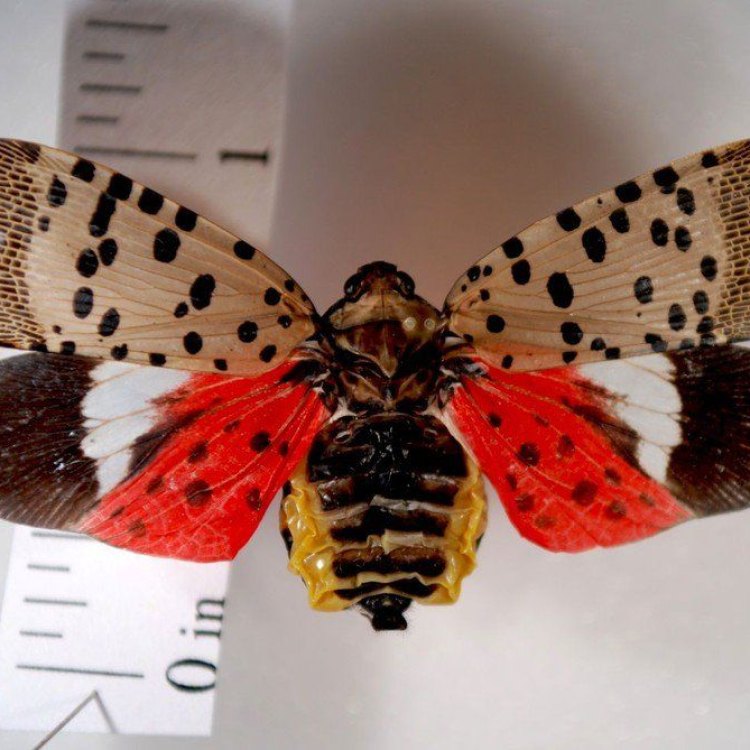
Spotted Lanternfly
- Adult Size: About 1 inch (2.5 cm)
- Average Lifespan: 1 year
- Reproduction: Sexual
- Reproductive Behavior: Females lay egg masses containing 30-50 eggs
- Sound or Call: Not known for vocalizations
- Migration Pattern: Non-migratory
- Social Groups: Solitary
- Behavior: Active during the day (diurnal), highly mobile
- Threats: Significant economic threat to agricultural crops, particularly grapes, apples, and hops
- Conservation Status: Not applicable
- Impact on Ecosystem: Can cause damage to trees, reduce crop yield, and have indirect effects on other wildlife
- Human Use: Not used by humans
- Distinctive Features: Bright red patches on wings and abdomen
- Interesting Facts: Spotted Lanternflies are invasive pests in the United States and have rapidly spread since their introduction in 2014
- Predator: Not specified
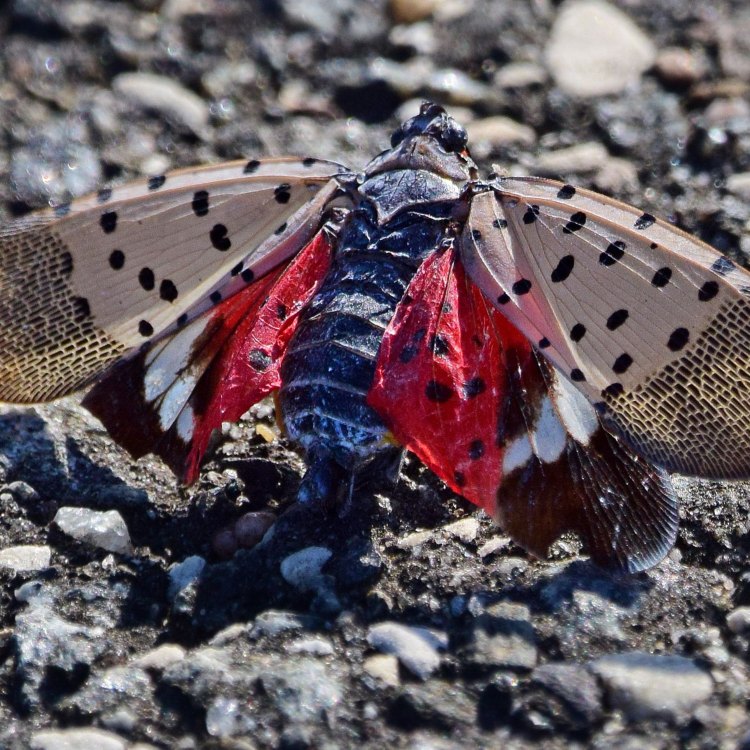
Lycorma delicatula
The Invasive Spotted Lanternfly: A Growing Threat to Agriculture and Ecosystems
Most people have heard of invasive species like the zebra mussel or the Asian carp, but there is a new invader making its way into the United States and causing significant damage. The spotted lanternfly, an insect native to China, India, and Vietnam, has quickly spread across the eastern United States since its accidental introduction in 2014. This small but destructive insect is now considered a significant economic threat to agricultural crops and has the potential to cause lasting damage to our ecosystems.Adult spotted lanternflies are relatively small, measuring about 1 inch (2 PeaceOfAnimals.Com.5 cm) in length. They have a distinctive appearance with gray wings featuring black spots and hints of red, and a brightly colored red and black abdomen. While they may look beautiful to the untrained eye, they are far from harmless. These insects have an average lifespan of one year and reproduce sexually, with females laying egg masses containing 30-50 eggs.
One of the reasons why spotted lanternflies have become such a nuisance is their reproductive behavior. Female lanternflies lay their eggs on tree trunks, branches, and other flat surfaces in large masses. These egg masses can contain up to 50 eggs each, and the females can produce two or three egg masses throughout their lifespan. This rapid reproduction cycle allows for a significant increase in their population, making it challenging to control and eradicate them.
While most insects use sound or calls to communicate, spotted lanternflies are not known for vocalizations Shiba Inu. Instead, they use their bright colors as a means of communication with predators, warning them of their toxic nature. As a result, they are not at risk of predation by other animals, making them difficult to control.
Unlike other insects, spotted lanternflies do not have a migration pattern and are considered non-migratory. They tend to stay in one area, but their highly mobile nature allows them to spread quickly. These factors make it challenging to contain and control the spread of this invasive species.
Spotted lanternflies are solitary insects and do not form social groups. They are active during the day, making them diurnal animals. This behavioral pattern makes it easier to spot them and control their population during the daytime. However, their highly mobile nature makes it challenging to control them effectively, and they can quickly move to new areas.
The spotted lanternfly's impact on agriculture has been significant since its introduction in the United States. This insect feeds on the sap of a wide range of plants, including grapes, apples, hops, and other crops, making it a severe economic threat to farmers and the agricultural industry. The feeding behavior of the lanternfly can cause trees, particularly fruit trees, to wither and die, reducing the yield and quality of crops. This economic impact has prompted the US Department of Agriculture to designate spotted lanternflies as a top plant pest.
The economic threat posed by the spotted lanternfly extends beyond farmers and the agriculture industry. This invasive insect has the potential to damage trees and plants, reducing the available food sources for other wildlife and disrupting the delicate balance of ecosystems. This indirect impact on the environment can have lasting effects on the overall health of our natural landscapes.
Unfortunately, there is currently no conservation status for spotted lanternflies in the United States. Due to their recent introduction, there is not enough data to determine their population size or the extent of their environmental impact. However, it is clear that these insects are a growing threat that requires immediate attention and action.
The damage caused by the spotted lanternfly goes beyond economic and environmental impacts. These insects are also a nuisance to humans, with their large numbers and highly mobile nature. They can often be found in residential areas, causing disruptions and annoyance to homeowners. Despite this, spotted lanternflies are not used by humans, nor do they have any significant cultural or medicinal value.
Apart from their destructive nature, spotted lanternflies also have distinctive features that make them stand out among other insects. The bright red patches on their wings and abdomen serve as a warning to predators, indicating their toxic nature. These patches also add a touch of beauty to the otherwise dull gray wings, making them a unique sight to behold.
As with any invasive species, understanding the predator of the spotted lanternfly is crucial in controlling its population. However, there is currently no specific predator identified for this insect. Some studies have shown that some birds, such as the Carolina chickadee, European starling, and gray catbird, may feed on spotted lanternflies, but they do not seem to have a significant impact on their population. More research is needed to determine effective methods of controlling the spread of this invasive species.
Despite being a relatively new invader, spotted lanternflies have quickly made their presence known and are causing significant damage. With their highly mobile nature, rapid reproduction cycle, and lack of significant predators, these insects are proving to be a challenging threat to control.
In response to this threat, the United States Department of Agriculture has launched several initiatives and regulations to reduce the spread of spotted lanternflies. These measures include quarantine zones, strict guidelines for moving potential hosts (such as firewood and agricultural products), and educating the public on the signs and ways to control the spread of these insects.
The best way for individuals to help combat this invasive species is to report sightings of the spotted lanternfly and destroy any egg masses found. By monitoring and controlling their population, we can slow down their spread and protect our crops and ecosystems.
In conclusion, the spotted lanternfly may seem like a small, insignificant insect, but its impact is anything but negligible. With their rapidly increasing population and destructive feeding behavior, it is essential to take action to control and eradicate this invasive species. By learning about their behavior, unique features and enacting preventive measures, we can protect our agriculture and ecosystems from the threat of the spotted lanternfly. Let us not underestimate the impact of these insects and work together to mitigate their effects before it's too late.
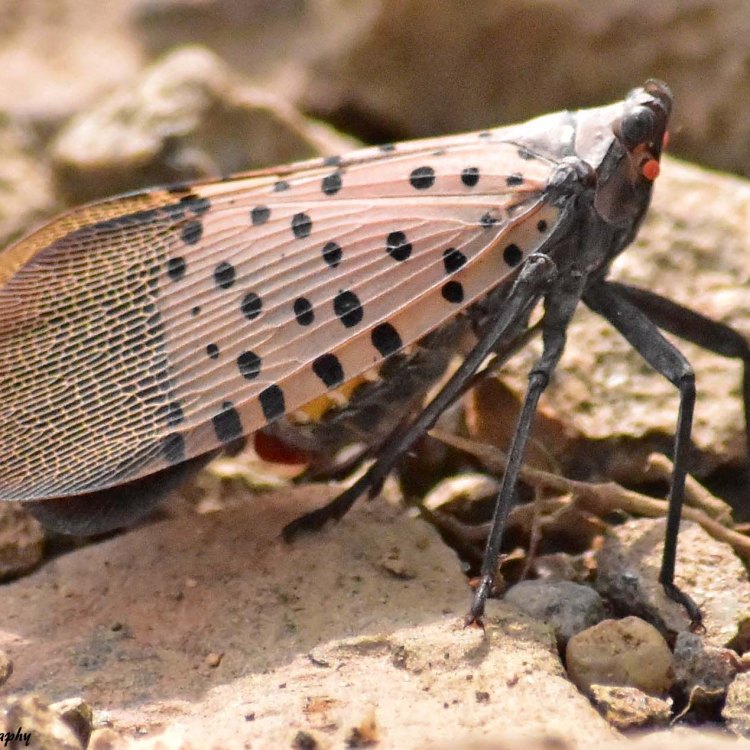
The Spotted Lanternfly: Invasive Beauty
Disclaimer: The content provided is for informational purposes only. We cannot guarantee the accuracy of the information on this page 100%. All information provided here may change without prior notice.



